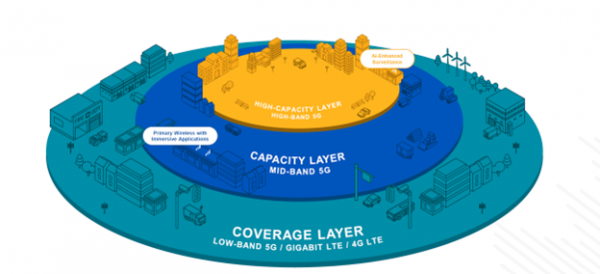Low, Mid, and High 5G Explained | CWNP - Guest Blog
By Casey Hyneman On 11/10/2022
In 5G, low, mid, and high refer to the frequencies used. RF travels in waves just like sound or light; technically, RF waves are nonvisible electromagnetic waves.
Think of it like this: you are sitting on the beach, and the waves are hitting the shore. Now, count how many waves hit the shore in a minute, and that's the frequency. Now with RF we use seconds, but you get the point.

In the graphic, you can see 5G low on the left, 5G mid in the middle, and 5G High on the right.
Just like with the water, the higher the frequency, the more water is being moved. In RF, the higher frequency, the more data can be moved. The downside to higher frequencies is they are more challenging to receive and process at greater distances.
LOW
The current strategy is to use the low band to provide nationwide coverage as it travels far but has lower data rates. We are currently in what's called NSA (non standalone) 5G. This means that it is using 5G down and 4G up. Until we get to SA (standalone), the advantages of 5G lowband will not be available. Keep in mind it will still be faster than your standard 4G but not the new gigabit LTE.
MID
The Mid band is the sweet spot. Its higher frequency allows us to see 600Mbps to 1Gbps speeds down, but we also get a decent range from it. Mid band is very close to Wi-Fi frequencies and will travel in a similar fashion. The main difference is that carriers can transmit at higher power levels and can use much weaker signals to a better effect than Wi-Fi can. The strategy for this band is city metro areas, city center, and suburbs.
HIGH
The high band is extremely high throughput. We could see speeds of 10Gbps. The issue is that it is such a high frequency that it travels very poorly. It is best with line of site, and most any obstruction will block the signal significantly, if not entirely. The current strategy for this is city centers, think of the carrier putting a high band (ultrawideband is one name commonly used for it) tower on the top of the tallest building in a downtown area, and then other buildings could put a W4005 on their roof that would have a clear line of site to the tower.

Some names used for different bands by carriers
Low= nationwide 5g, 5G
Mid= 5G, C band,
High= Ultrawideband, 5G+
Blog Disclaimer: The opinions expressed within these blog posts are solely the author’s and do not reflect the opinions and beliefs of the Certitrek, CWNP or its affiliates.



